Gallery
- Yue/Viet tribes pre-Han conquest
- Han conquest of Nanyue in 112 BC
- Ngô dynasty in 938
This is a timeline of Vietnamese history under Chinese rule from the 3rd century BC to 905.
| Year | Date | Event |
|---|---|---|
| 257 BC | Thục Phán of the Âu Việt invades Văn Lang and creates Âu Lạc [1] | |
| 207 BC | Qin general Zhao Tuo captures the Cổ Loa Citadel and defeats Âu Lạc, creating the two administrative regions of Jiaozhi (Giao Chỉ) and Jiuzhen (Cửu Chân) [1] | |
| 203 BC | Zhao Tuo declares himself king of Nanyue (Nam Việt) [1] | |
| Year | Date | Event |
|---|---|---|
| 198 BC | Two legates are assigned to oversee affairs in Jiaozhi and Jiuzhen [2] | |
| 181 BC | Nanyue attacks Changsha [3] | |
| 111 BC | Han conquest of Nanyue : Han general Lu Bode conquers Nanyue and separates it into Jiaozhi, Jiuzhen, Cangwu, Nanhai, Yulin, Hepu, Dan'er, and Zhuya. [4] Starts First Era of Northern Domination. [5] |
| Year | Date | Event |
|---|---|---|
| 2 | Census records for Jiaozhi, Jiuzhen, and Rinan record 143,643 households and a population of 981,755 [6] | |
| 40 | Trung sisters' rebellion : Yue tribes rebel in Jiaozhi [7] | |
| 42 | Trung sisters' rebellion : Ma Yuan leads an expedition to Jiaozhi [8] | |
| 43 | Trung sisters' rebellion : The Trưng Sisters are decapitated [7] |
| Year | Date | Event |
|---|---|---|
| 100 | A rebellion in Jiaozhi is put down [9] | |
| 136 | People known as the Qulian from beyond the southern frontier attack Rinan Commandery, causing turmoil and confusion [10] | |
| 137 | Rinan rebels [9] | |
| 144 | Rinan rebels [9] | |
| 157 | Chu Đạt rebels in Jiuzhen Commandery and is defeated [11] | |
| 160 | Shi Ci becomes administrator of Rinan [9] | |
| 190 | Shi Ci's son Shi Xie appoints his brothers Shi Yi, Shi Wei, and Shi Wu as administrators of Hepu, Jiuzhen, and Nanhai [12] | |
| 192 | The southernmost district of Rinan Commandery, Xianglin, breaks away and becomes the Kingdom of Lâm Ấp, otherwise known as Champa [13] |
| Year | Date | Event |
|---|---|---|
| 211 | Shi Xie submits to Sun Quan's overlordship [12] | |
| 217 | Shi Xie sends his son Shi Xin to Sun Quan as hostage [12] | |
| 226 | Shi Xie dies and Sun Quan's general Lü Dai kills his family; [12] Shi Xie, also called Sĩ Nhiếp in Vietnamese, is remembered today in Vietnam as the father of education and Buddhism - according to Stephen O'Harrow, he was essentially "the first Vietnamese" [14] | |
| 248 | Lâm Ấp (probably Champa) seizes Rinan while Lady Triệu rebels unsuccessfully against Sun Wu [14] |
| Year | Date | Event |
|---|---|---|
| 347 | Lâm Ấp invades Jiaozhi but is repulsed by the Jin dynasty (266–420) [15] | |
| 359 | Lâm Ấp is defeated [15] | |
| 377 | Li Xun seizes Jiuzhen [15] | |
| 380 | Teng Dunzhi becomes governor of Jiaozhi after Du Yuan kills Li Xun [15] | |
| 399 | Du Yuan becomes governor of Jiaozhi and defeats a Lâm Ấp invasion [15] |
| Year | Date | Event |
|---|---|---|
| 405 | Lâm Ấp attacks Jiaozhi [16] | |
| 410 | Du Yuan dies and is succeeded by Du Huidu [15] | |
| 411 | A rebel army under Lu Xun attempts to seize control over Jiaozhi but fails [17] | |
| 413 | Lâm Ấp attacks Jiaozhi [16] | |
| 415 | Lâm Ấp attacks Jiaozhi [16] | |
| 423 | Du Huidu dies and is succeeded by Du Hongwen [15] | |
| 424 | Lâm Ấp attacks Jiaozhi [16] | |
| 427 | Du Hongwen leaves Jiaozhi for the court after receiving an appointment [15] | |
| 443 | Tan Hezhi, governor of Jiaozhi, starts recruiting an army [18] | |
| 446 | Tan Hezhi invades Lâm Ấp and pushes them back to the area around modern Da Nang [18] | |
| 468 | Two brothers Lý Trường Nhân and Lý Thúc Hiến rebel against the Liu Song dynasty, emperor Emperor Ming of Song de jure recognizes Lý Trường Nhân as Thứ sử (province governor, cishi) [19] | |
| 485 | Lý Thúc Hiến surrenders to Qi Dynasty [20] |
| Year | Date | Event |
|---|---|---|
| 541 | Lý Bôn (503–548) rebels and attacks Liang officials [21] | |
| 544 | February | Lý Bôn establishes the Early Lý dynasty (Kingdom of Vạn Xuân) and becomes Lý Nam Đế (Southern Emperor) [22] |
| 545 | Chen Baxian drives Lý Nam Đế into the mountains, where he is eventually killed, but resistance continues under Lý Thiên Bảo [22] |
| Year | Date | Event |
|---|---|---|
| 602 | Sui–Former Lý War : Sui forces under Liu Fang annex the kingdom of Vạn Xuân [23] | |
| 618 | Transition from Sui to Tang : Sui military leaders in Jiaozhou follow Xiao Xian fight against the new Tang Empire [24] | |
| 622 | Transition from Sui to Tang : Li Yuan and his forces defeat Xiao Xian, then arrive Tống Bình (Hanoi). Jiaozhou governor Khâu Hòa (552–637) surrenders to Tang dynasty. Jiaozhou is incorporated into Tang Empire [25] | |
| 679 | Jiaozhi is renamed Annan (An Nam) [26] | |
| 687 | Lý Tự Tiên and Đinh Kiến revolt at Đại La in response to a raise in harvest tax [27] | |
| 691 | I-ching's book Commentary about Monks of the Great Tang mentions 6 Vietnamese Buddhist monks who traveled to India |
| Year | Date | Event |
|---|---|---|
| 722 | Mai Thúc Loan rebels in Annan and is defeated [28] | |
| 767 | Srivijaya fleets invade Annan and are defeated [28] | |
| 785 | Phùng Hưng rebels in Annan [29] | |
| 791 | Tang regains control of Annan [29] |
| Year | Date | Event |
|---|---|---|
| 803 | Champa seizes southern Annan [30] | |
| 846 | Nanzhao raids Annan [30] | |
| 858 | Rebellion breaks out in Annan and is put down [31] | |
| 861 | Nanzhao attacks Bo Prefecture and Annan but is repulsed. [32] | |
| 863 | Nanzhao conquers Annan [33] | |
| 866 | Gao Pian retakes Annan from Nanzhao and establishes the Jinghai Army (Military Command) [33] | |
| 874 | Tang dynasty launches a campaign against aboriginal forces [34] | |
| 877 | Troops deployed from Annan rebel in Guangxi [34] | |
| 879 | Campaign against aboriginal forces ends [34] | |
| 880 | A Tang garrison at Đại La mutinies, forcing Zeng Gun to withdraw troops from the south and relinquish control over Annan; ending de facto Chinese control over Vietnam [35] |
| Year | Date | Event |
|---|---|---|
| 904 | Zhu Wen's brother Quanyu tries to enter Annan but is immediately dismissed the next year for being "stupid and without ability" [36] | |
| 906 | Khúc Thừa Dụ of the Khúc clan takes control of Annan and establishes tributary relations with Later Liang [35] |
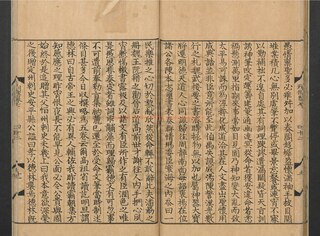
The Book of Sui is the official history of the Sui dynasty, which ruled China in the years AD 581–618. It ranks among the official Twenty-Four Histories of imperial China. It was written by Yan Shigu, Kong Yingda, and Zhangsun Wuji, with Wei Zheng as the lead author. In the third year of Zhenguan of the Tang dynasty (629), Emperor Taizong of Tang ordered Fang Xuanling to supervise the completion of the Book of Sui, which was being compiled around the same time as other official histories were being written. The Book of Sui was completed in 636 AD, the same year as the Book of Chen was completed.

Annan was an imperial protectorate and the southernmost administrative division of the Tang dynasty and Wu Zhou dynasty of China from 679 to 866, located in modern-day Vietnam. An Nam, simplified to "Annam", is the Vietnamese form of the Chinese name Annan, which means "the Pacified South" or "to pacify the South", a clipped form of the full name, the "Protectorate General to Pacify the South".

This is a timeline of the Three Kingdoms period (220–280) of Chinese history. In a strict academic sense, the Three Kingdoms period refers to the interval between the founding of the state of Cao Wei (220–266) in 220 and the conquest of the state of Eastern Wu (229–280) by the Western Jin dynasty (265–316) in 280. However, many Chinese historians and laymen extend the starting point of this period back to the Yellow Turban Rebellion that took place in 184 during the late Eastern Han dynasty (25–220).
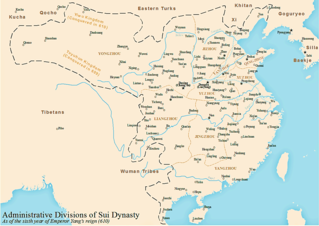
The Third Era of Northern Domination refers to the third period of Chinese rule in Vietnamese history. The era starts from the end of the Early Lý dynasty in 602 to the rise of the local Khúc family and other Viet warlords in the early 10th century, finally ending in 938 after the defeat of the Southern Han armada by the Viet leader Ngô Quyền. This period saw three Chinese imperial dynasties rule over what is today northern Vietnam: Sui, Tang and Wu Zhou. The Sui dynasty ruled northern Vietnam from 602 to 618, and briefly reoccupied central Vietnam in 605. The successive Tang dynasty ruled northern Vietnam from 621 to 690, and again from 705 to 880. Between 690 and 705, the Tang dynasty was briefly interrupted by the Wu Zhou dynasty which maintained Chinese rule over Vietnam.
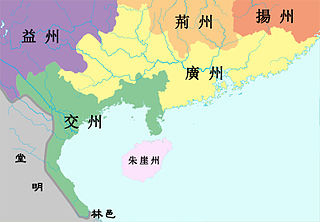
Jiaozhou was an imperial Chinese province under the Han and Jin dynasties. Under the Han, the area included Liangguang and northern Vietnam but Guangdong was later separated to form the province of Guangzhou by Sun Quan following the death of Shi Xie and lasted until the creation of the Annan Protectorate in 679.
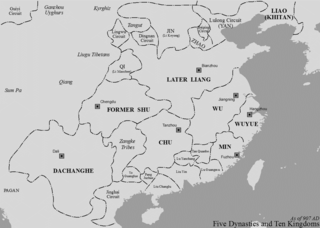
Tĩnh Hải quân or Jinghai Circuit, also known as Annan or An Nam, was an administrative division of the Tang dynasty of China administered by Chinese governors, which then later became a quasi-independent regime ruled by successive local Vietnamese warlords and monarchs. It was centered around what is now northern Vietnam from 866 to 967 during the late Tang period and lasted until the late Five Dynasties and Ten Kingdoms period when Đinh Bộ Lĩnh established the Đinh dynasty.

The Trưng sisters' rebellion was an armed civil uprising in the southern provinces of Han China between 40 CE and 43 CE. In 40 CE, the Luoyue leader Trưng Trắc and her sister Trưng Nhị rebelled against Chinese authorities in Jiaozhi. In 42 CE, Han China dispatched General Ma Yuan to lead an army to strike down the Luoyue rebellion of the Trưng sisters. In 43 CE, the Han army fully suppressed the uprising and regained complete control. The Trưng sisters were captured and beheaded by the Han forces, although Vietnamese chronicles of the defeat records that the two sisters, having lost to Han forces, decided to commit suicide by jumping down the Hát Giang river, so as not to surrender to the Han.
Jiuzhen was a Chinese commandery within Jiaozhou. It is located in present-day Thanh Hóa Province, Vietnam.

This is a timeline of the Tang dynasty. Information on areas and events relevant to the Tang dynasty such as the Wu Zhou interregnum, when Wu Zetian established her own dynasty, and other realms such as the Sui dynasty, Tibetan Empire, Nanzhao, the Three Kingdoms of Korea, Japan, and steppe nomads are also included where necessary.
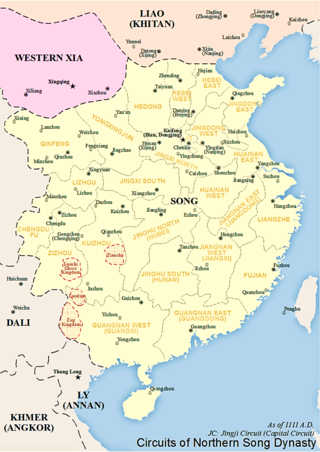
This is a timeline of the Song dynasty (960–1279). The Song dynasty was founded by Zhao Kuangyin, posthumously known as Emperor Taizu of Song, who ended the period of division known as the Five Dynasties and Ten Kingdoms period. The Song dynasty is commonly separated into two historical periods, the Northern Song (960–1127) and the Southern Song (1127–1279), divided by the loss of the north to the Jurchen Jin dynasty (1115–1234). In 1279, the Mongol Yuan dynasty conquered the Song.

This is a timeline of the Five Dynasties and Ten Kingdoms (907–979), which followed the collapse of the Tang dynasty in 907 AD. The Five Dynasties refer to the succession of dynasties which ruled northern China following the Tang collapse while the Ten Kingdoms, with the exception of Northern Han, ruled in southern China. This era of division ended in 979 AD with the rise of the Song dynasty under Emperor Taizu of Song, although the Song would never reconquer the northern territory lost to the Khitans, collectively known as the Sixteen Prefectures.

This is a timeline of the Jin dynasty (266–420) and the Sixteen Kingdoms (304–439).

This is a timeline of the Northern and Southern dynasties in China.

This is a timeline of the Sui dynasty.
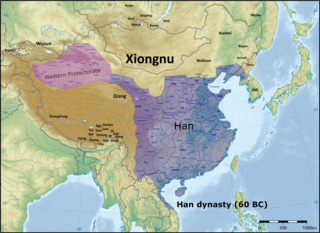
This is a timeline of the Han dynasty.
This is a timeline of Yunnan and Guizhou.

This is a timeline of the Xiongnu, a nomadic people that dominated the ancient eastern Eurasian steppes from 209 BC to 89 AD. The Xiongnu settled down in northern China during the late 3rd century AD following the Three Kingdoms period, and founded several states lasting until the Northern Liang was conquered by the Xianbei Northern Wei in 439 AD.

This is a timeline of Early Independent Vietnam, covering the period of Vietnamese history from the rise of the Tĩnh Hải circuit ruled by the Khúc clan to the kingdom of Đại Cồ Việt ruled by the Early Lê dynasty (980–1009).

This is a timeline of the Lý dynasty, which ruled Đại Cồ Việt (1009–1054), and then the renamed Đại Việt (1054–1226).